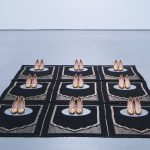The Los Angeles County Museum of Art (LACMA) presents Women Defining Women in Contemporary Art of the Middle East and Beyond, an exhibition comprising works by artists who were born or live in what can broadly be termed Islamic societies. Depicting a breadth of inventively and often ideologically conceived women’s imagery, the works bear witness to rapidly shifting political developments and often accelerated social transformations taking place in lands extending from Africa to Western, Central and Southern Asia, as well as in diasporic communities. Across generations and working in different media, the artists share a common sense of identity not exclusively “Middle Eastern” but certainly female, expressing both personal and universal concerns.
Included in the exhibition are around 75 works by 42 artists in a variety of media, most of which are in LACMA’s collection, with several newly acquired works on display at the museum for the first time, as well as a specially commissioned work by Rania Matar of the actress Iman Vellani, who plays Kamala Khan in the Disney+ miniseries Ms. Marvel.
“All the works in Women Defining Women are by women artists, and all depicting images of women. Each, through her unique vision, is fashioning not only her own definition of self but is helping to redefine and empower women everywhere,” said Linda Komaroff, Curator and Department Head, Art of the Middle East, at LACMA, who curated the exhibition. “In fact, half of LACMA’s Art of the Middle East’s Contemporary collection is made up of work by female artists, which is unique to contemporary museum collections.”
“LACMA has one of the strongest holdings of Middle Eastern contemporary art, the largest such institutional collection in the United States,” said Michael Govan, LACMA CEO and Wallis Annenberg Director. “The depths of our collection allows us to bring new narratives and perspectives to the fore, as seen in Women Defining Women. We are excited to share this exhibition with audiences in Los Angeles and beyond.”
Exhibition Highlights
Shadi Ghadirian, Be Colorful #2, 2022
Shadi Ghadirian’s work is deeply concerned with the role of women in Iran. As part of her focus on women, Ghadirian often comments on their contemporary condition, including their traditional role as homemakers as well as issues of dress. Since 1983, women have been mandated by law to wear hijab in public in Iran, and many conservative women choose to wear dark-colored chadors, a long, loose garment that covers the hair and body. The uniform-like similarity of the garments reduces a sense of individuality between wearers, a result challenged in Ghadirian’s Be Colorful series. Ghadirian poses her models in richly colored hijabs that distinguish each woman from the next, highlighting their visibility through vibrant hues even as they appear to be viewed through dirty panes of glass.
Almagul Menlibayeva, Homeland Guard, 2011
Almagul Menlibayeva uses clothing and fabric as languages of expression in her artwork, drawing from her experience studying textiles and applied arts. In Homeland Guard, Menlibayeva shows a bare-chested model partially clad in a uniform inspired by the Khazak Republican Guard, an epaulet affixed to her exposed shoulder. She seems to peer directly at the face of the skinned fox hanging downward from her hat and sticks her tongue out at it, a defeated enemy.
Hayv Kahraman, Search, 2016
Born in Baghdad, Hayv Kahraman left Iraq in 1991, when it was still under the rule of Saddam Hussein. Today, based in Los Angeles, she draws, paints and sculpts. Inspired by Islamic manuscript illustration, Italian Renaissance painting and Japanese woodcut prints, her works are informed by her own life experiences. Kahraman’s practice primarily engages with the female form, using herself as the model, often in a monochromatic palette, as here, where the disembodiment of the figures is about a process of cleansing and self-healing.
Laila Shawa, Disposable Bodies 4 (Shahrazad), 2011
Laila Shawa used paint, photography, silkscreen and sculpture to create vibrant works that are inspired by the lives of Palestinians living in Gaza, where she was born. Her penetrating series Disposable Bodies, in which brightly painted mannequin torsos are bedecked with large, colorful rhinestones, black lace or peacock feathers, and weapons or ammunition, references but is not meant to glorify violence. Rather, combining sensuality and the aura of threat, it vividly defines the value(lessness) of women’s lives in a patriarchal society that demands purity and conformity. In a more universal sense, the sculpture dramatically captures the notion of male dominance over female sexual agency.
Press release from the Los Angeles County Museum of Art (LACMA)



